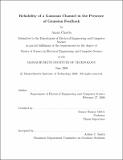| dc.contributor.advisor | Sanjoy Kumar Mitter. | en_US |
| dc.contributor.author | Chawla, Aman | en_US |
| dc.contributor.other | Massachusetts Institute of Technology. Dept. of Electrical Engineering and Computer Science. | en_US |
| dc.date.accessioned | 2007-07-17T19:40:47Z | |
| dc.date.available | 2007-07-17T19:40:47Z | |
| dc.date.copyright | 2006 | en_US |
| dc.date.issued | 2006 | en_US |
| dc.identifier.uri | http://hdl.handle.net/1721.1/37848 | |
| dc.description | Thesis (S.M.)--Massachusetts Institute of Technology, Dept. of Electrical Engineering and Computer Science, 2006. | en_US |
| dc.description | This electronic version was submitted by the student author. The certified thesis is available in the Institute Archives and Special Collections. | en_US |
| dc.description | Includes bibliographical references (leaves 29-30). | en_US |
| dc.description.abstract | The communication reliability, or error exponent, of a continuous time, infinite band-width, Additive White Gaussian Noise channel was studied under a peak power constraint, in the presence of a feedback channel that was also a continuous time peak-power constrained infinite bandwidth Additive White Gaussian Noise channel. Motivated by [9], a two phase scheme was studied, where, in the first phase, the Encoder transmits the message in small bit-packets and the Decoder then informs the Encoder of the decoded message. With this knowledge, in the second phase, the Encoder sends a confirm or deny signal to the Decoder and the Decoder then informs the Encoder of its final action. In the first phase, the Encoder uses an orthogonal signalling scheme and the Decoder uses a deterministic Identification code. In the second phase, the Encoder uses antipodal signalling, while the Decoder utilizes a sequential semi-orthogonal peak-power constrained anytime code. To improve the reliability of the anytime code, additional messages are pipelined into the forward channel by the Encoder once it finishes its phase two transmission, before receiving the Decoder's phase two transmission. | en_US |
| dc.description.abstract | (cont.) Using this scheme, the following lower bound on the reliability of this channel is obtained: where 4R is the average rate of data transmission and C are the capacities of where R is the average rate of data transmission and Ci and 02 are the capacities of the forward and reverse channels respectively. To achieve this reliability, the capacity of the reverse channel, C2 must be greater than the forward capacity C1. | en_US |
| dc.description.statementofresponsibility | by Aman Chawla. | en_US |
| dc.format.extent | 30 leaves | en_US |
| dc.language.iso | eng | en_US |
| dc.publisher | Massachusetts Institute of Technology | en_US |
| dc.rights | M.I.T. theses are protected by copyright. They may be viewed from this source for any purpose, but reproduction or distribution in any format is prohibited without written permission. See provided URL for inquiries about permission. | en_US |
| dc.rights.uri | http://dspace.mit.edu/handle/1721.1/7582 | |
| dc.subject | Electrical Engineering and Computer Science. | en_US |
| dc.title | Reliability of a Gaussian channel in the presence of Gaussian feedback | en_US |
| dc.type | Thesis | en_US |
| dc.description.degree | S.M. | en_US |
| dc.contributor.department | Massachusetts Institute of Technology. Department of Electrical Engineering and Computer Science | |
| dc.identifier.oclc | 136972702 | en_US |
